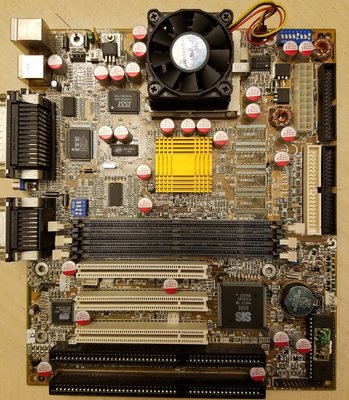640K!enough wrote:mockingbird wrote:You will have to drop the capacitance though, especially on the VRM high where you always need a 16V cap for the 12V input. So typically, for VRM high caps where there's space for only an 8mm part, you use something like 16V 270uF (whereas you'd use 16V 1000uF with an electrolytic).
Can someone explain why we are talking about using lower capacities with polymer capacitors? Is it just that they are physically larger (wider, rather than tall), and therefore the same capacity as the electrolytic being replaced won't fit, or is there a more technical reason behind it?
I would say mostly it's because polymer electrolytic capacitors that have same capacitance and voltage rating are just physically larger than standard low ESR aluminium electrolytic capacitors.
640K!enough wrote:
mockingbird wrote:Having said that, the theory behind using polymer caps in these types of VRMs is that you lose nothing by halving the capacitance because lower ESR is more important.
Is that always the case? Is it not a better idea to either replace with the same type, capacity and at least a safe voltage rating, or check the datasheet for the regulators used?
In an ideal world, a capacitor would have no series resistance (ESR which basically means how much the voltage will drop compared to an ideal capacitor when you draw current out of it) and no series inductance (ESL which basically means when you start pulling the current, how fast you are able to get it compared to an ideal capacitor).
Computer motherboards and many other devices have switching mode regulators. Basically depending on the switching frequency and max ripple voltage at maximum load, it only needs a certain minimum amount of capacitance at the VRM output that can be calculated to get the ripple below specified level that is necessary. Since there is ESR in real capacitors, it contributes to the ripple voltage, and thus you need to increase capacitance to get total ripple from capacitance and ESR below the specified level. That's why there are multiple capacitors on motherboard CPU voltage so that their ESRs and ESLs are paralleled to get lower ESR and ESL. So purely based on that, since polymer electrolytic capacitors do have smaller ESR (won't estimate how much), it means you can get off with smaller capacitance or fewer capacitors, as long as the total ripple is still below the required level.
It also basically means that you cannot take a look at switching mode regulator datasheet for example values, as they are just example values for example situations. When you are powering a CPU, you must know how much ripple voltage the CPU tolerates and then calculate how much capacitance you need to be safely below that level, given that you know the capacitor ESR and ESL as well. And then you get to choose the most economical way of achieving that goal, for example whether with a single expensive 10000uF ultra low ESR cap, or ten el cheapo 1000uF normal ESR caps.
So, halving the capacitance means doubling the capacitance ripple, so if ESR is low enough, it might compensate for it - but there will be a limit.
On the VRM input side, it may not be so sensitive.
640K!enough wrote:I seem to remember the datasheet for an IC I used a few years ago stating something like, "capacitor C2 must not have an ESR less than x".
That is typical limitation for LDO linear regulators, their feedback loop goes unstable if capacitor ESR is too low. Normal linear regulators usually don't have this limit.
So you kind of need to know the purpose of the circuit you are replacing the capacitors, whether it will improve, make it worse or does not really matter much.
For example blindly recapping a noisy old sound card with ultralow ESR superpolymers usually does not make it less noisy or otherwise sound better than recapping it with normal electrolytics.
Just like new super low ESR car battery won't make an old rusty car any faster even if can provide more current to crank the starter motor.
In some circuits lower ESR will make currents larger so some other parts may run hotter.
Usually the problem is elsewhere in the circuit design that makes it noisy. And for example speaker outputs don't get improved much if DC blocking caps of 0.080 ohm are replaced with 0.008 ohm caps, when the speaker impedance is 8 ohms.
Oh, and many times it seems that people only talk about electrolytic capacitors. There are other kind of capacitors as well that are also important in circuits, but recappers only seem to be mostly worried about the electrolytics.

